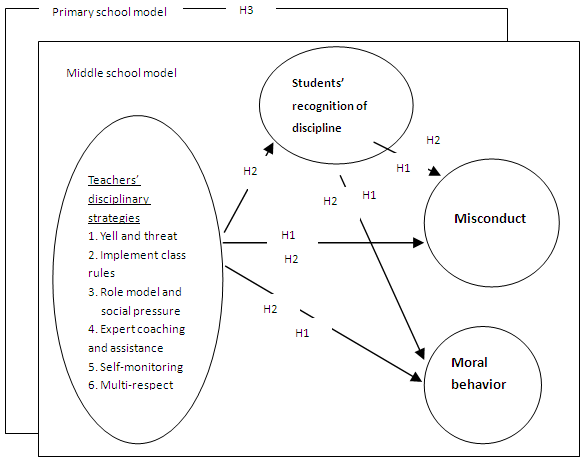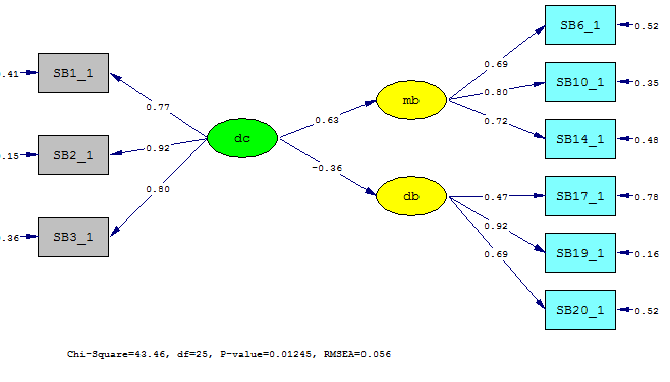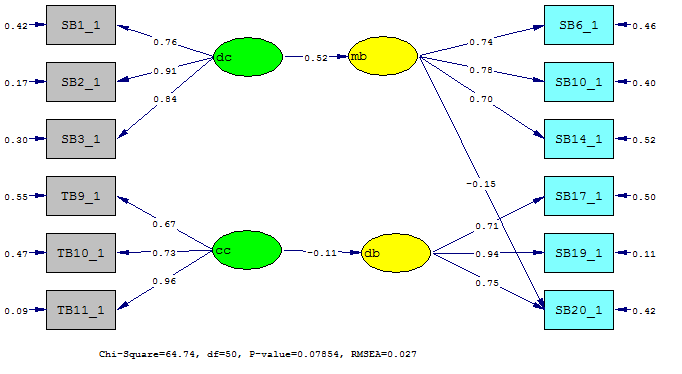-
Paper Information
- Paper Submission
-
Journal Information
- About This Journal
- Editorial Board
- Current Issue
- Archive
- Author Guidelines
- Contact Us
American Journal of Sociological Research
p-ISSN: 2166-5443 e-ISSN: 2166-5451
2017; 7(5): 133-137
doi:10.5923/j.sociology.20170705.02

Relation between Teachers' Disciplinary Strategy, Students' Recognition, and Student Behavior
1Department of Early Childhood Education, National University of Tainan, Taiwan, R.O.C.
2Department of Education, National Taitung University, Taiwan, R.O.C.
Correspondence to: Yi-Gean Chen, Department of Early Childhood Education, National University of Tainan, Taiwan, R.O.C..
| Email: |  |
Copyright © 2017 Scientific & Academic Publishing. All Rights Reserved.
This work is licensed under the Creative Commons Attribution International License (CC BY).
http://creativecommons.org/licenses/by/4.0/

In recent years, the misconduct of students has become increasingly serious, and many teachers are worried that there may be complaints by parents if they are too easy or too hard on students. Thus, they tend to avoid disciplinary issues to avoid complaints, and retire one day without causing many troubles. This paper found that there are six kinds of statistical strategies for teachers in middle and primary schools, including reprimand and punishment, social pressure and role models, expert counseling and social assistance, multiple respect, self-monitoring, strict implementation of class rules. The results of regression analysis and structural equation analysis showed that: in terms of the misconduct of primary school students, primary school teachers can still strictly implement class rules to control misconduct; while middle school teachers should adopt the compound strategy of expert counseling and student assistance to improve discipline recognition and indirectly reduce misconduct. Regarding student's moral behavior, the research data showed that improving discipline recognition has great relevance on the promotion of students’ moral behavior.
Keywords: Students’ misconduct, Disciplinary strategy, Student’s moral behavior
Cite this paper: Yi-Gean Chen, Jao-Nan Cheng, Relation between Teachers' Disciplinary Strategy, Students' Recognition, and Student Behavior, American Journal of Sociological Research, Vol. 7 No. 5, 2017, pp. 133-137. doi: 10.5923/j.sociology.20170705.02.
Article Outline
1. Introduction
- Many countries around the globe are witnessing their politics moving towards democratization. This is also true for schools, with adjustments being made to disciplinary matters between teachers and students. Due to democratization in schools, the traditional discipline of teachers is limited by governments, which results in students’ increasingly serious misconduct (Kinch, Lewis-Palmer, Hagan-Burke, & Sugai, 2001, p480). Many teachers worry that there may be complaints by parents if they are too hard or easy on their students, thus, they are inclined to protect themselves from such complaints. Hence, researchers have found that teachers adopt relatively passive disciplinary strategies, meaning they do not necessarily employ appropriate disciplinary strategies. Inappropriate discipline may bring about discontent among students, teacher-student conflicts, and even give rise to serious educational problems in the future. However, schools are not short of experienced teachers who spare no efforts to actively control the misconduct and irregularities of students, and yield good results. This study seeks to conduct a systematical study and draw conclusions for teachers who wish to improve students’ behavior. Some expert teachers are capable of correcting the behavior of students, thus, winning students’ recognition for their disciplinary strategies (Lapointe, 2003, p11), which may also lead students to positive moral behavior and perception (Zsolnai, 2003). This study intends to examine the disciplinary strategies of teachers with high student recognition, in order to reduce misconduct and cultivate moral behavior. In addition, this study analyzes the impact of the disciplinary strategies on the students' disciplinary recognition, misconduct, and moral behavior, as well as the effects of disciplinary strategies in elementary schools.
2. Literature Review
- Barbetta et al. suggested that when the general teachers deal with the misconduct of students, they tend to adopt the following two strategies, yelling in a loud voice or punishment (Barbetta, Norona, & Bicard, 2005, p12). Lane, Pierson, and Givner (2003, p413) revealed that teachers have three main disciplinary strategies: the self-monitoring strategy, cooperation strategy, and arbitrary strategy. Kulinna (2007: p23) pointed out that the disciplinary strategies of US schools’ are, as follows: remove/refer, positive action, behavior modification, punishment, expert, peer, threats, and keep busying. The survey of Heaviside et al. showed that schools’ disciplinary issues are related to students’ misconduct (Heaviside, Rowand, Williams, & Farris, 1998, p15). Hayes et al. pointed out that the cultivation of moral behavior depends on whether students abide by the rules, meaning teachers’ discipline of students’ moral behaviors are relate to the cultivation of students’ moral behavior. Lapointe pointed out that whether students accept or agree with teachers’ discipline will affect students’ behavior (Lapointe, 2003, p11).
3. Research Design
- (1) Research Structure and Hypotheses1. Research StructureThis research mainly discusses the impact of teachers' disciplinary strategies on students' misconduct and moral behaviors, as well as the relation between these variables, with the intermediary variables being students' recognition of disciplinary measures. Therefore, the preposition variable is teachers’ disciplinary strategies, the results variables are student’s misconduct and moral behavior, the intermediary variables are students' agreement with discipline, and gender is the control variable of this study. On the basis of the differences in the degrees of misconduct among middle and primary school students, or differences in teachers' teaching experiences, this study attempts to analyze the impact of middle school teachers’ disciplinary strategies on students’ misconduct and moral behavior, as well as the relation between these model variables, the impact of primary school teachers’ disciplinary strategies on students’ misconduct and moral behavior, and the relations between the model variables.
 | Figure 1. The Research Structure Model of Compound Disciplinary Strategy and Student Behavior |
4. Research Results and Discussion
- 1. Impact of teachers’ disciplinary strategies and disciplinary approval on students’ misconduct and moral behavior (1) Impact of primary teachers’ disciplinary strategies and disciplinary approval on students’ misconduct and moral behaviourRegression analysis finds that the disciplinary strategies of primary school teachers can predict misconduct. The more the rules are implemented, the less misconduct primary school students commit. Discipline recognition can effectively predict moral behavior, and it can be seen that, the more students agree with teachers’ disciplinary strategies, the higher their moral behavior. (2) Impact of middle teachers’ disciplinary strategies and disciplinary approval on students’ misconduct and moral behavior Regression analysis finds that the discipline of middle school teachers can effectively predict moral behavior and misconduct. It can be seen that, the more students agree with teachers' disciplinary strategies, the higher their moral behavior and the less their misconduct. In this study, disciplinary strategy/expert counseling and social assistance may be found from the materials of middle school cases for predicting students’ recognition. This means that the disciplinary strategies used by middle school teachers must be recognized by students; the higher the degree of recognition, the higher the moral behavior and the less the misconduct of students. In addition, the compound disciplinary strategy of expert counseling and social assistance is adopted to predict discipline recognition; in terms of the disciplinary issues of middle school students, teachers need to consult experts and ask students to help other students with their misconduct. In this way, disciplinary strategies will be better recognized and students can behave better. In conclusion, this study finds that students' discipline recognition is significantly correlated to their moral behavior and conduct; this finding is similar to that of Lapointe's research, which revealed that whether students accept teachers’ discipline will affect students’ behavior (Lapointe, 2003, p11). In addition, this study finds that the result is similar to that of Reynolds and Ceranic (2007, p1610), which held that moral behavior is related to discipline recognition. However, students in middle and primary schools are somewhat different. Middle school students’ recognition of discipline can normally predict their moral behavior and misconduct, while primary school students’ recognition of discipline may have effect their moral behavior, but not misconduct. Instead, strictly implementing class rules is conducive to significant prediction of primary school students’ misconduct. Furthermore, the study also finds that the compound strategy of expert counseling and social assistance can predict discipline recognition, which is most suitable for middle school teachers. 2. The relation model between middle school teachers’ disciplinary strategy, students discipline recognition, and misconduct and moral behavior In order to further construct the relation model between the compound disciplinary strategy of middle school teachers, students’ recognition, and moral behavior and misconduct, analysis is conducted through structural equation, and the following results are obtained (Figure 2).
 | Figure 2. A Study on the Relationship between Middle School Students’ Recognition, Moral Behavior, and Misconduct (Note: dc/ disciplinary strategies, mb/ moral behavior, db/ misconduct) |
5. Conclusions and Suggestions
- In recent years, the misconduct of students has become increasingly serious, and many teachers are worried that there may be complaints by parents if they are too easy or too hard on students. Thus, they tend to avoid disciplinary issues to avoid complaints, and retire one day without causing many troubles. This paper found that there are six kinds of statistical strategies for teachers in middle and primary schools, including reprimand and punishment, social pressure and role models, expert counseling and social assistance, multiple respect, self-monitoring, strict implementation of class rules, and other strategies. The results of regression analysis and structural equation analysis showed that: in terms of the misconduct of primary school students, primary school teachers can still strictly implement class rules to control misconduct; while middle school teachers should adopt the compound strategy of expert counseling and student assistance to improve discipline recognition and indirectly reduce misconduct. Regarding student's moral behavior, the research data showed that improving discipline recognition has great relevance on the promotion of students’ moral behavior.
 Abstract
Abstract Reference
Reference Full-Text PDF
Full-Text PDF Full-text HTML
Full-text HTML